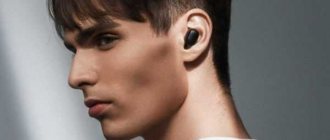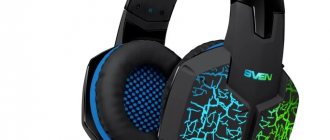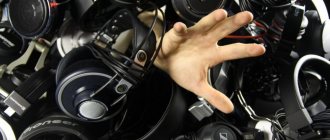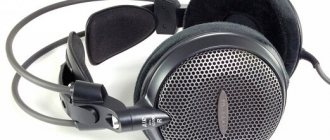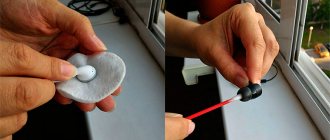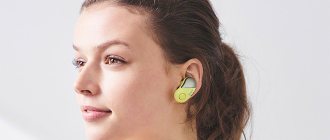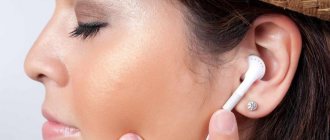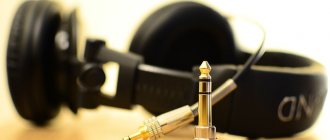Today there are a huge number of wireless headphones on the market that work wirelessly via Bluetooth and are suitable for any phone, computer or TV. What do they look like, which ones are better to choose on AliExpress and not get lost in this variety? In this article I will not make any comparison of stereo headsets - whether they have good sound or not, how easy they are to operate, etc. I’ll just try to highlight the main characteristics that will help you figure out what kind of wireless headphones there are for music or audio texts, and how to make the right choice among on-ear headphones, earbuds, or earbuds.
Simple wireless Bluetooth headphones
The very first type, which appeared on the market many years ago together, are wireless headphones that are connected to each other by a wire. In this case, either on this cord or in one of the modules there is a Bluetooth signal receiver, through which they are connected to any electronics, be it a phone, computer, laptop or TV.
This type of wireless headphones has long established itself among users because it is characterized by very stable operation and high quality communication with the sound source. However, it also has several subtypes:
- On-ear headphones are classic-shaped headphones that look identical in appearance to computer headphones, only without wires. They can be either large professional ones with massive ear pads, or compact and even with a folding design that you can take with you on the road.
Usually on one of the “ears” there is a music playback control unit, from which you can switch between tracks or pause it.
- Earplugs are a more mobile device in which the headphones are attached to each other with a thin plastic bow or simply a thicker wire, on which the control unit is also located. There can be a huge number of their varieties, but the main thing is that they are inserted inside the ears, so that almost no extraneous sounds penetrate into them.
True Wireless Bluetooth (TWS) Headphones - No Wires
But technology does not stand still, and not more than a year ago a new type of wireless headphones appeared - True Wireless, or TWS for short. They are distinguished by the fact that these headphones are without a wire - even the one that connects them to each other. And they also connect to each other via Bluetooth. Each of the headphones has a wireless module, but one of them is the master. Thus, it simultaneously connects to both the phone and the second earphone.
As you understand, the stability of the connection becomes significantly lower than in simple ones. Therefore, in cheap models there are often disconnections or desynchronization, which is why the sound goes only to one ear. However, more expensive brands have everything in order, so you shouldn’t be afraid of problems with their operation.
Among TWS headphones, there are also two categories based on the type of wear they wear - earbuds and earbuds.
- Plugs are a familiar type to us, which I described a little higher. Headphones are inserted into the ear canal, blocking the access of extraneous noise. Good for listening to music, but potentially dangerous when worn outdoors. Since, for example, when crossing a road, you may not hear the sound of an approaching vehicle. Another disadvantage is the fact that the microphone on them is located far from the mouth, which means it is difficult to use them as a conversational headset - the sound reaching the interlocutor is of very poor quality. But they are small and do not catch the eye of passers-by. An example of such a model is CaseGuru CGPods
- Earbuds are another type that we have Apple to thank for introducing. It was their AirPods that began to use this method of placement in the ear, which other brands then began to copy. Such wireless headphones are not inserted inside, but rather “nested” inside the ear, leaving room for extraneous sounds to penetrate. It's much safer because you can hear everything going on around you. However, complete immersion in music does not occur. And in appearance, such an accessory hanging from the ear looks dubious. But the microphone located at the very end of the stem transmits speech much more clearly when talking on the phone through them.
- Plugs “with a stem” are a combined type in which they are inserted into the ears like plugs, but at the same time have a long stem with a microphone. To some extent, the best option if you are not bothered by “sticks” sticking out of your ears.
How to choose wireless headphones
- Pay attention to the type of headphones: earbuds, earplugs, on-ear, monitor.
The classification is based on the distance the speaker is located to the ear. In-ear headphones are small in size, held in the ear by elastic force, but have poor low frequency reproduction.
Vacuum headphones provide clear and high-quality sound and have a soundproofing effect, so they are used for listening to music in transport and noisy rooms. The disadvantage of such products is the high load on the ears.
- On-ear headphones with a special mount are suitable for gamers; they are expensive. Full-size devices cover the ears completely, can be closed or open, and provide good sound insulation. Disadvantage: large dimensions.
- Choose headphones depending on the purpose. To listen to music you will need compact devices with a good playback frequency.
Gamers and recording studio workers are recommended to buy full-size, closed-back headphones. For sports, models with moisture resistance and frost resistance are required.
- Be sure to consider the size and weight of the headphones. The most compact are earbuds and vacuum devices weighing 5-30 grams, overhead models weigh 40-100 grams, and monitor models weigh 150-300 grams.
- Duration of work is another important criterion.
Good models provide operation without recharging for about 30-40 hours, and work in autonomous mode for 2-4 days.
This indicator depends on the type and functionality of the device. The optimal time for recharging is 2-3 hours.
- Pay attention to the package contents of the product, the presence of a warranty card, and instructions for use. Buy devices from trusted manufacturers.
Important parameters:
- Buy headphones with high frequency sound reproduction. As a rule, our ear detects frequencies from 15-16 Hz to 18000-20000 Hz.
In order to listen to the entire spectrum, choose models with a frequency of up to 20 GHz. High frequencies are harmful to the human ear.
- Pay attention to the sensitivity of the device. The standard indicator is up to 100 dB.
- The resistance characteristic for portable equipment ranges from 16 to 50 Ohms. The impedance for a computer is 32-80 Ohms; for working in the studio you will need headphones with an impedance of 200-300 Ohms.
The power of the model should be from 1 mW to 5000 mW.
- Sound distortion is a characteristic that determines sound quality. Choose products that distort sound by no more than 1 percent.
- Pay attention to the shape of the model of overhead and full-size products; they should fit tightly on the head, but at the same time be comfortable. To do this, select devices with a streamlined shape and durable mount.
- When choosing headphones for your computer, consider the presence of a microphone and volume control.
- It’s good if the products have a noise-absorbing effect, then nothing can distract you from your favorite activity.
Secondary parameters:
- Choose the color of the products and design according to your preferences, it doesn’t matter.
- As a rule, modern models are designed to operate within a radius of 10 meters. This indicator is quite sufficient. But headphones for a metal detector should have a higher performance – from 20 meters.
How to choose wireless headphones for your phone, computer or TV?
Now that we know about all the types of wireless headphones, let's decide how to choose them. Next, I will talk specifically about Bluetooth wireless headphones, since this topic is the most relevant today. I’ll say right away that they are suitable for TV, and for PCs, and for any phone on all operating systems, that is, both for the iPhone (iOS) and all Android smartphones.
What should you pay attention to when purchasing on AliExpress?
Sound quality
Of course, the most important parameter for music lovers. While you can listen to text using the most inexpensive headphones, listening to music requires surround and high-quality sound. If this moment is the most critical for you, then take a more expensive model from a well-known brand and most likely you won’t go wrong. JBL, Sennhaiser, Apple are companies that have long established themselves in the market as industry leaders.
Headphone size
As they say, size matters. And we are not talking about rubber ear pads here - they can be changed to fit your ear for ease of wearing. I mean external modules - the larger they are, the better the quality of the speaker and the larger the battery capacity that can be placed in it. However, outwardly they will look more bulky. Such, for example, Havit G1 - cool “ears”, but very large. Therefore, here you need to find a middle ground between appearance and filling.
Case form factor
A small, neat case not only looks sleeker, but is also easier to carry. For example, Haylou GT1 or Redmi AirDots can easily fit even into a jeans pocket. The downside is the ability to place a small battery in it, which affects the overall autonomy of the wireless headphones.
A large case is more practical in this regard, but you can’t put it in your pocket.
It is also worth focusing purely on the design of the box - its material, coating, quality of workmanship and assembly.
Autonomy
A very important parameter. It is influenced by two factors - the capacity of the built-in battery on the headphones themselves and the volume of the battery in the case. Usually good headphones last up to 3 hours in playback mode. At the same time, the average case has the ability to recharge them up to 4 times. As a result, we get 12 hours of continuous operation. Considering that we don’t listen to music around the clock, then with active use, one charge lasts for 2-3 days. A very good indicator, considering that they replenish energy quite quickly.
Charging time
This characteristic follows from the previous one. The small case and headphones not only drain quickly, but also take less time to charge. If some will charge all night (although unlikely), then for others an hour will be enough to reach 100%.
Powerbank built into the case
There are headphone models (Awei T8) in which the case has the ability to simultaneously act as a portable external battery. In case of emergency, you can even recharge your smartphone from this.
Charging connector
As a rule, any Bluetooth headphones come with a charging cable. Most often this is micro USB or Lightning for AirPods analogues. Recently, more and more models with USB-C have been found. Although there are also instances where the manufacturer is frankly greedy and does not put such an inexpensive thing as a wire in the box.
In any case, you need to be guided by what cables you have available. If you use phones or other equipment with a micro USB connector, then it is more logical to take headphones with the same one. If you lose it, you won’t have to buy a new one, and one wire is never enough. I personally carry one with me, one at work, one at home, one in the car.
Wireless charger
A relatively new feature that is present in more and more wireless headphone cases today. As for me, the matter is controversial, since inserting a cable into the port does not present any difficulty. But if you already use a phone and wireless charging, then why not? But such models are much more expensive, so whether it makes sense to overpay or not is up to you to decide.
Additional ear pads
Again, in most cases, several rubber bands of different sizes are included in the set of headphones. You can choose from them those that do not put pressure on the ear canal and at the same time do not pop out while walking.
Also, sometimes additional silicone spacers are included in the kit, which help to more securely fix the earphone in the ear, or hooks that go over the ear. This is typical for sports models that are more demanding in terms of resistance to active movements.
Control key type
Any Bluetooth headphones have a function button. However, it can be of two types - physical, which you need to press, and sensory, which responds to touches. Regular readers of the blog know that I prefer the physical one, since it does not have false clicks.
The sensor reacts to any slightest touch, even if you adjust your hat in winter. Proponents of the sensor note that the disadvantages of the physical sensor are that you need to press it hard, and this causes unpleasant sensations. But I can say that in high-quality modifications the pressing occurs very softly and clearly, so that it does not respond to the ear in any way, but is even tactilely pleasant.
Control functions
In any headphones, the buttons are programmed with certain tasks for controlling music and answering calls. The basic set is start-stop, switching to the next or previous track, picking up and hanging up.
However, you can also look for those in which the functionality is more flexible. For example, calling a voice assistant or increasing or decreasing the sound volume. There are also models where tasks are distributed between the right and left modules. For example, with Bluedio Hi Hurricane, pressing the right one is the next track, and pressing the left one is the previous one.
Magnetic mount
In the most budget models, the cover of the case has a mechanical latch in the form of a bead on the plastic. It looks cheap, isn't very pretty, and is hard to open with one hand. And over time it wears off and ceases to perform its function.
It is much more technologically advanced when a magnet is built into the case and the lid slams shut with a pleasant click. At the same time, it does not open when shaking, but can easily be folded back with one finger.
The same applies to mounting wireless modules in the case. It’s cool when they easily fly into their nests on a magnet and don’t fall out even with the lid open. In more inexpensive variations, they are either mounted on a pin, which is typical for in-ear headphones (Harper HB-508). Or they are simply placed in grooves and not secured there in any way, however, this is very rare today.
You can also pay attention to the convenience of placing them in the box and taking them out from there. For example, in the first generation Havit G1, their position inside was not obvious, which made putting them in place awkward.
Automatic switching on
Today, the vast majority of TWS headphones automatically turn on and connect to any phone immediately after they are taken out of the case. The only exception to the modem is the first unpacking and activation. And they also turn off and begin to charge when placed inside. But again, there are manufacturers who have saved on such a simple function. Their models have to be turned on manually each time using buttons. And they start charging only when you press a button on the case.
Indication
Personally, I don't like to attract attention from others. Therefore, for me it is optimal when the external modules have only small LEDs that blink only when turned on, synchronized or charged.
But there are also those that blink in different colors, like a Christmas tree, throughout the entire operation. Somewhere this is implemented beautifully, like in BLitzWolf FYE-5. And in some places it’s completely clumsy, as in numerous cheap copies on Apple.
Package
This characteristic is more relevant when choosing wireless headphones as a gift, since it does not affect the Bluetooth connection in any way. For example, the same Ausdom TW01 were packaged in nondescript brown eco-cardboard packaging with a monochrome image and text. At the same time, the headphones themselves turned out to be very worthy.
But one cannot help but admit that the quality and beauty of the box leads to an increase in the final cost, but it immediately creates a mood and leaves a pleasant impression of unpacking.
Of all the ones I had the chance to hold in my hands, the most “premium” ones were the same Havit G1 in a cool, stylishly designed box with glass and thick detailed instructions.
Manufacturer
The last thing you should focus on is the brand under which certain accessories are sold. The loud story of the exposure of Black Stars TWS headphones, which were sold for more than 7 thousand rubles, is still fresh in my memory. And exactly the same ones, but without their logo, could easily be ordered on AliExpress for 1500.
We also found similar clones of the clone, which are the same in quality, but differ in cost - these are BlitzWolf FYE-4 and WaveFun X-Pods 2. Of course, a well-known brand is a guarantee of quality (if it is not a fake), but you can find exactly the same a variant released with a different name at a much lower price.
TWS headphones for dummies. How are they different and which one is better to choose?
Reader rating for this article: 4.9
(93)
TWS headphones are becoming more and more popular every day. The term TWS (True Wireless Stereo) itself translates as truly wireless stereo and means headphones that are not connected by wire either to a smartphone or to each other.
This class of devices appeared in December 2021, when Apple introduced its first TWS headphones, AirPods. And today this company occupies a leading position in the market. According to the analytical company Strategy Analytics, in 2021, every second TWS headphones sold in the world were Apple AirPods (market share - 54.4%):
In general, over 107 million devices were sold in 2021 and this figure will only grow in the future. For example, according to analysts from Counterpoint, more than 100 million AirPods alone will be sold in 2020. And Strategy Analytics estimates the TWS headphone market at $100 billion/year by 2024 (more than 1.2 billion devices).
All this suggests that users are growing in interest in this class of products, and in this regard, we will tell you how different TWS headphones differ, what to look for when purchasing, and how to choose the best option.
Please note : many headphone models in the article will be highlighted with links. By clicking on the link you can read our detailed review of a specific model.
TWS headphones and sound quality
Obviously, one of the main criteria when choosing headphones, whether TWS or regular, is sound quality. And there are a lot of nuances and misconceptions here.
By design, all TWS headphones are divided into two types: in-ear and in-ear. A lot depends on this parameter alone, so let’s immediately look at what their differences are.
TWS earbuds
These are headphones that are placed in the auricle and do not tightly close the ear canal. An example of such devices are the mentioned Apple AirPods or Huawei FreeBuds 3:
Huawei FreeBuds 3 TWS earbuds
Their main advantage is precisely the fact that the ear canal remains open. Accordingly, such headphones do not create a feeling of “vacuum” in the ears, do not completely block out external sounds and do not hear your voice loudly during a conversation.
The earbuds are very convenient to use as a headset. They are quickly and easily inserted into the ears, have one size and do not create discomfort when worn.
The main disadvantage of earbuds is the same open ear canal. The fact is that only with complete isolation of external sounds can you achieve the deepest bass and the highest quality sound.
For this reason, earbuds are not considered “musical” headphones in the full sense of the word. You will never find a musician using earbuds on stage. In addition, finding expensive earbuds on sale (even wired ones) is very rare, since in-ear models often dominate the Hi-Fi segment (here we are not taking into account on-ear and full-size headphones).
In-ear TWS headphones
In-ear headphones, as the name suggests, are inserted directly into the ear canal, isolating it from external sounds. Such headphones are always supplied with a set of interchangeable ear pads (tips) of different sizes to take into account the physiological characteristics of each user.
There are plenty of examples of in-ear TWS headphones: Apple AirPods Pro, Xiaomi AirDots, Samsung Galaxy Buds, Sony WF-1000XM3 and many others.
In-ear TWS headphones from Sony and Apple
Of course, the type of headphones itself says absolutely nothing about the sound quality, but at a minimum, in-ear headphones will provide more bass on a noisy street than earbuds. All other things being equal, the sound of in-ear headphones will be richer and richer, especially in a noisy place.
The speaker size of TWS headphones does not affect the sound quality!
Many manufacturers indicate the size of the speakers of their TWS headphones, sometimes even emphasizing this. This is especially true for Chinese companies. In reality, the size of the speaker has nothing to do with sound quality and only misleads the buyer.
The analogy with speaker systems suggests that the larger the speaker, the deeper and more powerful the bass it produces. Accordingly, the smaller the speaker, the better it reproduces high frequencies (the same tweeter is several times smaller than the woofer). However, this does not work with in-ear headphones.
Many models with tiny drivers (~6 mm) produce deeper and better bass than headphones with huge drivers (~14 mm). The best examples are the aforementioned Sony WF-1000XM3 (6 mm speaker) and Huawei FreeBuds 3 (14.2 mm speaker). Sony headphones sound an order of magnitude better across the entire frequency range, delivering deeper bass and cleaner highs.
One of the most famous (now former) Sennheiser engineers, Axel Grell, has always considered the optimal speaker size for in-ear headphones to be within 6.5 mm . Further increase in size, at a minimum, does not improve sound quality.
Therefore, the last parameter that you should pay attention to when choosing TWS headphones is the size of their speakers.
However, the speakers themselves play one of the key roles, since they ultimately reproduce all the sounds. What matters is what materials they are made of, as well as what frequency range they are able to reproduce. But these parameters only indirectly indicate sound quality.
Codec support and audio volume for TWS headphones
Many people make one mistake, believing that the cost and quality of a smartphone can somehow miraculously affect the sound quality of Bluetooth headphones. This common misconception comes from the analogy of wired headphones.
The fact is that when we connect a wire, the signal from digital must be converted to analog, and then sent to the headphones through this wire. The quality of digital-to-analog conversion is of great importance and is responsible for this special device inside the smartphone called a DAC.
But when we connect wireless headphones, there is and cannot be any conversion from digital to analog. The signal must be sent in digital format via Bluetooth to the headphones, and the TWS headphones, having received this digital signal, convert it to analog before sending it to the speakers.
Accordingly, the DAC and amplifier of the smartphone do not have any effect on the sound quality of wireless headphones. It all depends on the DAC and amplifier, which are built directly into the headphones. For the same reason, the volume of headphones often does not depend on the smartphone. But sometimes there are exceptions when the volume is limited by software by the smartphone.
And yet, something in a smartphone can affect the sound quality - this is the set of supported codecs . For a better understanding, we need to look at this issue in more detail.
The main problem with wireless audio is Bluetooth bandwidth. We cannot send uncompressed files with a high bitrate (data flow rate) to headphones via Bluetooth. The bitrate of most Bluetooth headphones is limited to 256 or 328 kbps.
No matter how high-quality our audio file is (even flac with a bitrate of 1411 kbps), a file with a quality not exceeding mp3 (320 kbps) will reach the headphone DAC.
This happens because the smartphone first compresses (encodes) the source file with certain losses, and then sends it to the headphones. Those, in turn, must decode the signal. But since certain data was lost during compression, it will not be returned during decoding.
The same codecs . The smartphone and headphones must support the same codecs in order to “understand” each other. The basic SBC codec is supported by all devices in the world. But support for other codecs depends on the specific model. By the way, some smartphones also do not support all codecs. This is especially true for those devices that do not operate on the Qualcomm platform (for example, smartphones from Huawei or some Xiaomi).
In theory, if the headphones support, for example, the LDAC codec , we can get Hi-Res sound in maximum quality with virtually no loss. That is, there will be no difference between high-quality wired headphones and Bluetooth with LDAC support (in terms of sound quality). After all, the LDAC codec supports data transmission with a bitrate of up to 990 kbps , which is 3 times higher than when using SBC or AAC codecs.
Therefore, when choosing headphones, you can pay attention to the supported codecs. If you sort them in ascending order of quality, then the list will look like this:
- SBC
- A.A.C.
- aptX
- aptX HD
- HWA(LHDC)
- LDAC
But here, unfortunately, not everything is so simple. No matter how high-quality (lossless) the sound file is, if the headphones have a bad audio chip, this will not play any role. There are cheap Chinese TWS headphones on the market with support for aptX and aptX HD codecs, which will sound an order of magnitude worse than high-quality models with only SBC support.
In other words, almost any characteristic of TWS headphones gives only an indirect “hint” about sound quality. And some of the most important parameters cannot be measured or assessed at all. We are talking about such key concepts as:
Space, stage width and depth, instrument separation
For example, what's wrong with the expensive Apple AirPods Pro headphones? They have large drivers (11 mm), good frequency range, and excellent ear canal isolation. And, nevertheless, comparing their sound quality with the sound quality of the Sony WF-1000XM3 or, especially, the Sennheiser Momentum TW, is completely incorrect.
These models from Sony and Sennheiser have incredible instrument separation as well as stage feel. By increasing the volume, you only “push” the sound (scene) to the sides. The sound of one instrument does not affect the sound of all the others. There is no “mess” of sounds even on the most complex compositions.
All this cannot be reflected in the device specifications.
Or take a more banal thing, such as sibilance, when certain sounds are played with an unpleasant whistle that hurts the ear. How can this be displayed on the product website?
There is only one conclusion that can be drawn. There are TWS headphones on the market that are almost as good in sound quality as expensive wired models, but you can choose them either based on reviews or check them yourself when purchasing. All parameters that describe sound are greatly influenced by marketing. If something is measured in numbers, those numbers can be "stretched" in many ways without necessarily improving the actual quality of the product.
Using TWS headphones as a headset
Many people buy TWS headphones for use, including as a headset (for talking on the phone). It doesn’t matter whether you are saving yourself from phone radiation in this way or it’s just more convenient for you, you need to understand that not all TWS headphones cope well with this task.
First of all, don't forget about the design of the headphones. Inserts will be the most convenient in this regard. On the other hand, there are quite a few in-ear headphones on the market that feature sound permeability . When this technology works, headphones use microphones to pick up external sounds and send them through the speaker at a certain volume. As a result, it seems as if there are no headphones at all.
However, this feature does not work equally on all models. For example, the first Galaxy Buds sound like a hearing aid in this mode. The Sennheriser Momentum TW and Sony WF-1000XM3 are nicer in this regard.
And in the Apple AirPods Pro headphones, this function is literally brought to perfection. When you turn on the permeability mode, the headphones seem to disappear. You hear all surrounding sounds without the slightest distortion.
AirPods Pro
First conclusion: to work as a headset, it is better to use earbuds or in-ear headphones with sound permeability mode.
The second important point is the number of microphones in the headphones. If each TWS earphone has only one microphone, it will be very difficult to use them for conversation in a noisy place. The person you're talking to will hear all the noise around you, perhaps even louder than your voice.
Two or more microphones on each earbud are used for noise cancellation to cut out all extraneous sounds.
However, two microphones are not a panacea. Some models still do a poor job of canceling noise during a call, especially in a noisy place. The same Sony WF-1000XM3 is a clear negative example.
Sony WF-1000XM3
But there is also the opposite example, when headphones are literally “tailored” for use in headset mode. Take, for example, Huawei FreeBuds 3 with microphones hidden inside the “legs” to protect against wind, as well as with a vibration sensor that amplifies the sound that occurs when the jaw joint vibrates. We talked about this in more detail in the corresponding review.
What else is important to pay attention to when choosing TWS headphones
In addition to all of the above, TWS headphones differ from each other in additional functions. Let's briefly consider the most popular of them:
Noise suppression
ANC (from the English Active Noise Cancellation - active noise reduction) is a special software and hardware algorithm that suppresses (damps) external sounds. With these headphones you can comfortably listen to music even in the noisiest places.
The very principle of noise reduction is very simple - with the help of microphones, the headphones pick up all external sounds and then play them in antiphase. That is, the rise of the wave of one sound signal (say, the sound of a car outside) coincides with the decline of the wave of another signal (the same sound of a car recorded by a microphone and played in antiphase). Because of this, the effect of damping the sound wave occurs (since the waves overlap each other):
Ideally, external sound should disappear completely, but in practice this effect is difficult to achieve even with full-size headphones.
If you don't understand all these terms (antiphase, sound wave, etc.), then read our new popular science article about what active noise cancellation is in headphones.
Typically, active noise cancellation is found on in-ear headphones, but there are rare exceptions when this function also works on earbuds.
Active noise cancellation is available in such TWS headphones as:
- Apple AirPods Pro
- Audio-Technica ATH-ANC300TW
- Sony WF-1000XM3
- Jabra Elite Active 65t
- Huawei FreeBuds 3
- Xiaomi Air Mi True Wireless
Built-in equalizer
An equalizer can be found in many music applications on a smartphone. It allows you to change the sound character of melodies by increasing or decreasing the volume of certain frequencies. For example, you can add bass or make more high frequencies.
The problem with such equalizers is that they work exclusively in one application. As soon as you launch another application, the headphones will return to their previous (factory) sound.
But there are TWS headphones with a built-in equalizer, which is configured not in a specific music application, but in a proprietary program produced by the headphone manufacturer. By adjusting the equalizer once, the sound will be identical in all applications.
Not all models have a built-in equalizer. For example, not a single AirPods or Xiaomi has it. But it is available on Samsung Galaxy Buds, headphones from Sony and Sennheiser.
Branded application
Some headphones have proprietary applications that allow you to update the firmware and configure various functions. To check whether a specific headphone model supports an application, simply search for its name in the Google Play Store or AppStore (depending on which platform you need the application for).
Autonomy
Pay attention to how long the headphones last on a single charge, how many full charge cycles the case’s battery lasts for, and whether the case supports wireless charging.
There are cases when the headphones do not turn off completely in the case, but continue to work in a special energy-saving mode. This allows them to reconnect to the device very quickly when opening the case. However, this advantage is fraught with rapid self-discharge of the headphones and case when you do not use them.
For example, Apple AirPods can stay in a case for a month without running out of charge, and Sennheiser Momentum TW will drain its own battery and the case’s battery in just a week, even if you haven’t picked them up.
And that is not all…
Some models have additional unique features. For example, AirPods Pro constantly measure the volume of music using internal microphones and record it in the application, assessing the impact on your hearing:
Sony is able to suppress external sounds while at the same time amplifying people's voices, that is, the noise of cars will be muffled, but the conversation of people will not. Huawei headphones allow you to adjust the intensity of noise cancellation. And sometimes there is a Multipoint function, thanks to which headphones can be simultaneously connected to two devices and, for example, listen to music from a laptop while staying in touch by phone.
As you can see, TWS headphones differ from each other not only in appearance and sound quality. And given the specifics of this topic, it is advisable to check the sound yourself before purchasing. Or, at a minimum, read high-quality and unpaid reviews, which is what we actually do at Deep-Review!
PS
We have opened a Telegram channel and are now preparing very interesting materials for publication! Subscribe in Telegram to the first popular science site about smartphones and technology so you don’t miss anything!
Did you like the article? Share with others:
- 1
- 1
How would you rate this article?
Click on the star to rate it
There are comments at the bottom of the page...
Write your opinion there for all readers to see!
If you only want to give a rating, please indicate what exactly is wrong?
conclusions
How can we sum it up?
- All modifications of Bluetooth headphones from all manufacturers are suitable for any phone.
- Price is not always an indicator of quality, but a well-known brand definitely guarantees it.
- We especially pay attention to the fit in the ear - to understand which form factor is suitable. It is advisable to come to the store and try on several different models first.
- If we want to play sports in them, then we need the headphones to be equipped with additional fasteners.
- If the quality of the microphone for a conversation is important, we take it with a stand.
- For a neat appearance, it is better to take those wireless headphones that are smaller in size.
- For greater autonomy, we look the other way around, at larger modules or with an impressive case.
- Under no circumstances do we take models costing up to 1000 rubles. They will not please you with either the sound quality or performance
- It is better to choose the same power connector for wireless headphones as your phone for interchangeability.
- Wireless charging and external battery function are an additional nice bonus
